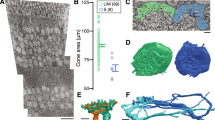Abstract
THE retinae of Old World primates contain three classes of light-sensitive cone, which exhibit peak absorption in different spectral regions1–4. But how are the different types of cone arranged in the hexagonal mosaic of the fovea? This question has often been answered with artists' impressions5–7, but never with direct measurements. Staining for antibodies specific to the short-wave photopigment has revealed a sparse, semiregular array of cones8; but nothing is known about the arrangement of the more numerous long- and middle-wave cones. Are they randomly distributed, with chance aggregations of one type, as Hartridge postulated in these columns nearly 50 years ago9,10? Or do they exhibit a regular alternation, recalling the systematic mosaics seen in some non-mammalian species6,11? Or, conversely, is there positive clumping of particular cone types, as might be expected if local patches of cones were descended from a single precursor cell? We have made direct microspectrophotometric measurements of patches of foveal retina from Old World monkeys, and report here that the distribu tion of long- and middle-wave cones is locally random. These two cone types are present in almost equal numbers, and not in the ratio of 2:1 that has been postulated for the human fovea.
This is a preview of subscription content, access via your institution
Access options
Subscribe to this journal
Receive 51 print issues and online access
$199.00 per year
only $3.90 per issue
Buy this article
- Purchase on Springer Link
- Instant access to full article PDF
Prices may be subject to local taxes which are calculated during checkout
Similar content being viewed by others
References
Bowmaker, J. K., Dartnall, H. J. A. & Mollon, J. D. J. Physiol. 298, 131–143 (1980).
Baylor, D. A., Nunn, B. J. & Schnapf, J. L. J. Physiol. 390, 145–160 (1987).
Hárosi, F. I. J. gen. Physiol. 89, 717–743 (1987).
Bowmaker, J. K. et al. J. exp. Biol. 156, 1–19 (1991).
Walraven, P. L. Vision Res. 14, 1339–1343 (1974).
Lythgoe, J. N. The Ecology of Vision (Oxford Univ. Press, Oxford. 1979).
Williams, D. R. et al. in From Pigments to Perception (eds Valberg, A. & Lee, B. B.) (Plenum, New York, 1991).
Curcio, A. C. et al. J. comp. Neurol. 312, 610–624 (1991).
Hartridge, H. Nature 153, 45–46 (1944).
Hartridge, H. Nature 157, 482 (1946).
Bowmaker, J. K. & Kunz, Y. W. Vision Res. 27, 2101–2108 (1987).
Liebman, P. A. & Entine, G. J. opt. Soc. Am. 54, 1451–1459 (1964).
Knowles, A. & Dartnall, H. J. A. The Photobiology of Vision (Academic, London, 1977).
Mollon, J. D., Bowmaker, J. K. & Jacobs, G. H. Proc. R. Soc. B 222, 373–399 (1984).
Dobelle, W. H., Marks, W. B. & MacNichol, E. F. Jr Science 168, 1508–1510 (1969).
Hartridge, H. Phil. Trans. R. Soc. 232, 519–671 (1947).
Reid, R. C., Shapley, R. M. Nature 356, 716–718 (1992).
Lennie, P. & Haake, P. W., in Computational Models of Visual Processing (eds Landy, M. S. & Movshon, J. A.) 71–82 (MIT Press, Cambridge, MA, 1991).
Marc, R. E. & Sperling, H. G. Science 196, 454–456 (1977).
de Monasterio, F. M., Schein, S. J. & McCrane, E. P. Science 213, 1278–1281 (1981).
Anhelt, P. K., Kolb, H. & Pflug, R. J. comp. Neurol. 255, 18–34 (1987).
Cicerone, C. M. & Nerger, J. L. Vision Res. 29, 115–128 (1989).
Pokorny, J., Smith, V. C. & Wesner, M. F. in From Pigments to Perception (eds Valberg, A. & Lee, B. B.) (Plenum, New York, 1991).
Mollon, J. D. J. exp. Biol 146, 21–38 (1989).
Author information
Authors and Affiliations
Rights and permissions
About this article
Cite this article
Mollon, J., Bowmaker, J. The spatial arrangement of cones in the primate fovea. Nature 360, 677–679 (1992). https://doi.org/10.1038/360677a0
Received:
Accepted:
Issue Date:
DOI: https://doi.org/10.1038/360677a0
This article is cited by
-
The Contribution of Adaptive Optics to Our Understanding of the Mechanisms of Color Vision in Humans
Neuroscience and Behavioral Physiology (2023)
-
Transcriptional regulation of photoreceptor development and homeostasis in the mammalian retina
Nature Reviews Neuroscience (2010)
-
The machinery of colour vision
Nature Reviews Neuroscience (2007)
-
The arrangement of the three cone classes in the living human eye
Nature (1999)
-
A patchwork of cones
Nature (1999)
Comments
By submitting a comment you agree to abide by our Terms and Community Guidelines. If you find something abusive or that does not comply with our terms or guidelines please flag it as inappropriate.



